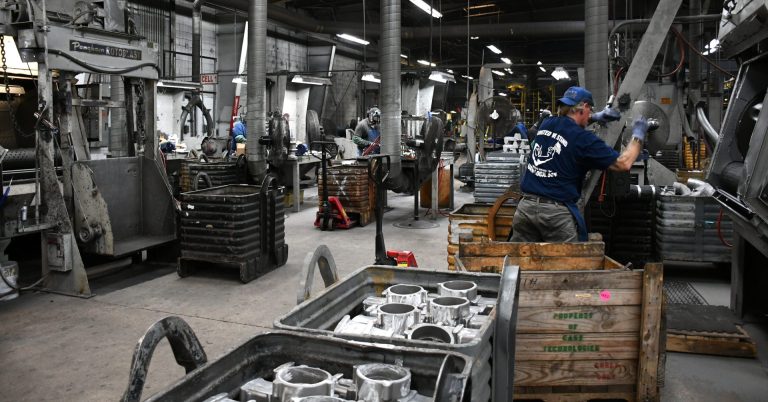The Ultimate Light Weight Aluminum Casting Guidebook: Step-by-Step Directions for Success

Safety Safety Measures for Aluminum Casting

In addition, preserving a tidy work space cost-free of clutter can prevent tripping threats and help with the movement of workers throughout casting processes. aluminum casting illinois. Appropriate training in dealing with liquified aluminum and operating casting tools is crucial to reduce the risk of injuries and accidents. Routine tools maintenance and assessment must be carried out to identify and correct any kind of potential security threats immediately
Establishing Your Aluminum Spreading Workspace
Establishing a risk-free and reliable office for aluminum spreading is important for guaranteeing smooth operations and minimizing prospective risks. Prior to setting up your workspace, make sure that it is well-ventilated to protect against the buildup of damaging fumes generated during the spreading process. It is essential to have actually a designated location for each stage of the spreading process, such as pattern making, mold prep work, and metal putting, to enhance workflow and stop cross-contamination.
Picking the Right Aluminum Alloy
To ensure ideal casting leads to your safety-focused and efficient work space, picking the suitable light weight aluminum alloy is critical. Various light weight aluminum alloys use diverse qualities such as toughness, sturdiness, warmth resistance, and machinability. The option of alloy relies on the particular needs of your casting task.
One commonly made use of light weight aluminum alloy for casting is A356. This alloy exhibits excellent fluidity, making it suitable for intricate castings with slim wall surfaces. A356 also has great corrosion resistance and mechanical buildings, making it suitable for a large array of applications.
If greater strength is required, 7075 light weight aluminum alloy is a preferred selection. Known for its high strength-to-weight ratio, 7075 redirected here is often utilized in applications where strength is essential, such as aerospace elements.
For jobs that include high-temperature atmospheres, 319 light weight aluminum alloy is an excellent alternative due to its superior thermal conductivity and resistance to thermal breaking.

Step-by-Step Aluminum Spreading Refine
Commencing the aluminum spreading process involves precise prep work and adherence to an exact series of steps to guarantee the manufacturing of top notch castings. The primary step is pattern production, where a replica of the final item is made from plastic, timber, or metal. This pattern is then utilized to develop the mold, which can be made from products like sand or plaster. As soon as the mold is prepared, it is time to thaw the aluminum in a heating system at temperature levels exceeding 1200 ° F.
After reaching the wanted temperature, the molten aluminum is put right into the mold and mildew dental caries. This action calls for care and accuracy to stay clear of issues in the my response last spreading.
Throughout the entire procedure, cautious surveillance and top quality control measures should be carried out to make certain the last aluminum spreading satisfies the required specifications and criteria.
Tips for Improving Your Casting Technique
In refining your aluminum casting strategy, meticulous interest to information and adherence to accurate steps are paramount to ensuring the manufacturing of high-grade spreadings. One crucial tip for perfecting your casting technique is to carefully prepare the mold and mildew and ensure it is clean and effectively coated with a release agent to assist in the simple elimination of the casting. Inspecting the casting for any type of blemishes and making required adjustments to the procedure will assist you boost and ideal your light weight aluminum casting technique over time.
Conclusion
In verdict, following appropriate security precautions, setting up an appropriate work space, selecting the proper light weight aluminum alloy, and carefully complying with the step-by-step casting procedure are essential for effective light weight aluminum spreading. By paying attention to these key elements and incorporating tips to refine your technique, you can attain superb lead to your light weight aluminum casting jobs.
From safety and security preventative measures to perfecting casting methods, this manual serves as a beacon of understanding for those venturing right into find more the world of light weight aluminum spreading.
Commencing the aluminum casting procedure includes careful prep work and adherence to a specific collection of steps to ensure the manufacturing of top notch castings.In refining your light weight aluminum spreading method, thorough interest to information and adherence to accurate steps are vital to making sure the manufacturing of high-grade spreadings. One crucial suggestion for refining your casting method is to thoroughly prepare the mold and mildew and ensure it is clean and effectively covered with a release representative to help in the easy removal of the casting. Evaluating the casting for any type of blemishes and making required modifications to the procedure will certainly help you enhance and perfect your light weight aluminum casting technique over time.